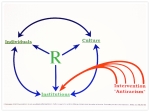
- A native of Puerto Rico, Jessica identifies as a “1.5 generation Queer ESL Latina of Puerto Rican descent.” She works as a consultant and core/organizer trainer for Crossroads. Jessica holds a BA in Criminal Justice and Master degrees in Theological Studies and Divinity.
In this final post, I am reflecting on the two remaining dynamics the Black/White racial binary paradigm creates for people of color which ensure the continuous re-centering of Whiteness as the dominant and only valid experience of this nation.
Dynamic 4: The Black/White racial binary paradigm allows white people to simply ignore their own investment in both racist constructs and their participation in them.
There is no example more powerful in recent day than the Donald Sterling debacle. The wealthy lawyer and purported slumlord who owns the L.A. Clippers, an NBA team, was caught on tape asking his biracial girlfriend to not bring African- Americans to his team’s games nor post photos of herself accompanied by them. Immediately, collective outrage took over this nation. White people were coming out of the woodwork to condemn his “racist behavior.” When NBA commissioner Adam Silver banned Sterling from the NBA for the rest of his life progressive white people everywhere breathed a collective sigh of self-satisfaction. The good white people have won. But as Ta-Henisi Coates opines it is easy to condemn the oafish, classless, inelegant racism of the likes of Sterling and rancher Cliven Bundy. What is never easy, what is costly for White people is to address what Coates refers to as “elegant racism,” which he describes in this way: “Elegant racism lives at the border of white shame. Elegant racism was the poll tax. Elegant racism is voter ID laws.” It is one thing for white people to express outrage at the overt unapologetic racism of Sterling and rise to the defense of African-Americans. It is another thing entirely for White people to own the ways in which they support, benefit, and leave unchallenged “elegant forms” of racism like stand your ground laws, mass incarceration policies, the privatization of prisons, the continued colonization of native lands, and anti-immigrant laws, just to name a few.
Dynamic 5: The Black/White racial binary paradigm stunts our creativity for visionary organizing and revolutionary collaborations.
I still remember the day one of my supervisors was fired. Over a decade has passed and I can still feel the weight of guilt for the ways in which my silence aided in the process of his dismissal. The situation was complex particularly because we felt no solidarity with each other. As an older African-American man in his sixties working in a profoundly racist liberal White institution he had learned to distrust anyone claimed by the White power structure. That included me. I was a 26-year old Latina claimed by the structure he distrusted as exceptional and set up as an example of what “good” people of color were supposed to be. His upbringing and the crazy-making construct of race had led him to believe that I was not a person of color but an honorary member of the White community. My upbringing in a colony of the United States and the crazy-making construct of race had led me to believe that I needed to stay away from him in order to succeed. I sometimes wonder how our work, our lives would have been different if we had seen each other as colleagues in the same struggle. I wonder how our organizing would have been more effective if we had been able to acknowledge that while the strategies were different, our dehumanization by racism was the same. I wonder how our communities would have been affected if we collaborated in ways that witnessed respect; maybe a revolution?
Among the most damaging effects of the Black/White racial binary paradigm is the way in which it eliminates the possibility of transformative collaboration among people of color groups and between White and people of color communities. When creativity is compromised the ability to formulate strategies to debunk the binary and the White supremacist worldview that produces it is inhibited.
The five dynamics I have reflected upon in this blog series threaten our struggle for human dignity. While alone I cannot stop these, I can join others in the struggle for human liberation. For the last 15-years I have given my time, energy, and creativity to Crossroads Antiracism Organizing and Training because it gifts me with a community of people working out of a shared analysis to strategize and organize cultural and institutional interventions that disrupt the divide-and-conquer strategies which threaten to seduce me away from my liberation and from the struggle for transformed community.




You must be logged in to post a comment.